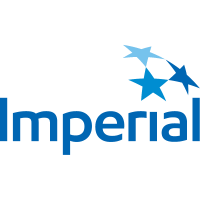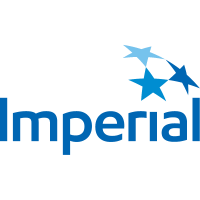
Imperial Oil Ltd
TSX:IMO


| US |

|
Johnson & Johnson
NYSE:JNJ
|
Pharmaceuticals
|
| US |

|
Berkshire Hathaway Inc
NYSE:BRK.A
|
Financial Services
|
| US |

|
Bank of America Corp
NYSE:BAC
|
Banking
|
| US |

|
Mastercard Inc
NYSE:MA
|
Technology
|
| US |

|
UnitedHealth Group Inc
NYSE:UNH
|
Health Care
|
| US |

|
Exxon Mobil Corp
NYSE:XOM
|
Energy
|
| US |

|
Pfizer Inc
NYSE:PFE
|
Pharmaceuticals
|
| US |

|
Palantir Technologies Inc
NYSE:PLTR
|
Technology
|
| US |

|
Nike Inc
NYSE:NKE
|
Textiles, Apparel & Luxury Goods
|
| US |

|
Visa Inc
NYSE:V
|
Technology
|
| CN |

|
Alibaba Group Holding Ltd
NYSE:BABA
|
Retail
|
| US |

|
JPMorgan Chase & Co
NYSE:JPM
|
Banking
|
| US |

|
Coca-Cola Co
NYSE:KO
|
Beverages
|
| US |

|
Walmart Inc
NYSE:WMT
|
Retail
|
| US |

|
Verizon Communications Inc
NYSE:VZ
|
Telecommunication
|
| US |

|
Chevron Corp
NYSE:CVX
|
Energy
|
Utilize notes to systematically review your investment decisions. By reflecting on past outcomes, you can discern effective strategies and identify those that underperformed. This continuous feedback loop enables you to adapt and refine your approach, optimizing for future success.
Each note serves as a learning point, offering insights into your decision-making processes. Over time, you'll accumulate a personalized database of knowledge, enhancing your ability to make informed decisions quickly and effectively.
With a comprehensive record of your investment history at your fingertips, you can compare current opportunities against past experiences. This not only bolsters your confidence but also ensures that each decision is grounded in a well-documented rationale.
Do you really want to delete this note?
This action cannot be undone.

| 52 Week Range |
84.39
140.84
|
| Price Target |
|
We'll email you a reminder when the closing price reaches CAD.
Choose the stock you wish to monitor with a price alert.

|
Johnson & Johnson
NYSE:JNJ
|
US |

|
Berkshire Hathaway Inc
NYSE:BRK.A
|
US |

|
Bank of America Corp
NYSE:BAC
|
US |

|
Mastercard Inc
NYSE:MA
|
US |

|
UnitedHealth Group Inc
NYSE:UNH
|
US |

|
Exxon Mobil Corp
NYSE:XOM
|
US |

|
Pfizer Inc
NYSE:PFE
|
US |

|
Palantir Technologies Inc
NYSE:PLTR
|
US |

|
Nike Inc
NYSE:NKE
|
US |

|
Visa Inc
NYSE:V
|
US |

|
Alibaba Group Holding Ltd
NYSE:BABA
|
CN |

|
JPMorgan Chase & Co
NYSE:JPM
|
US |

|
Coca-Cola Co
NYSE:KO
|
US |

|
Walmart Inc
NYSE:WMT
|
US |

|
Verizon Communications Inc
NYSE:VZ
|
US |

|
Chevron Corp
NYSE:CVX
|
US |
This alert will be permanently deleted.
Imperial Oil Ltd
Imperial Oil Ltd., a cornerstone in Canada's energy sector, stands as an industrial titan with a storied legacy intertwining innovation and resilience. Founded over a century ago, Imperial Oil has been intimately involved in the exploration, production, and marketing of petroleum products. The company's operations span across the full value chain—from upstream activities like oil sands development and conventional crude oil and natural gas exploration, to downstream operations that include refining crude oil, as well as distributing and marketing petroleum products under the well-recognized Esso and Mobil brand names. This dual approach allows for not only a diversified revenue stream but also a strategic balance between raw material extraction and refined product sales.
The financial engine of Imperial Oil is fueled by its ability to efficiently process raw hydrocarbons into consumable petroleum products that energize industries and fuel daily life. At its core, the company capitalizes on advanced technologies and operational expertise to maximize output while minimizing environmental impact, a growing consideration in today's energy discourse. With a considerable stake owned by ExxonMobil, Imperial Oil benefits from global expertise and technological prowess, further strengthening its competitive position in the market. This integration enables Imperial Oil to navigate the complexities of global and regional markets, adapting to fluctuating demands and geopolitical dynamics, thereby ensuring steady profitability along with sustainable growth for investors and stakeholders alike.

Imperial Oil Ltd., a cornerstone in Canada's energy sector, stands as an industrial titan with a storied legacy intertwining innovation and resilience. Founded over a century ago, Imperial Oil has been intimately involved in the exploration, production, and marketing of petroleum products. The company's operations span across the full value chain—from upstream activities like oil sands development and conventional crude oil and natural gas exploration, to downstream operations that include refining crude oil, as well as distributing and marketing petroleum products under the well-recognized Esso and Mobil brand names. This dual approach allows for not only a diversified revenue stream but also a strategic balance between raw material extraction and refined product sales.
The financial engine of Imperial Oil is fueled by its ability to efficiently process raw hydrocarbons into consumable petroleum products that energize industries and fuel daily life. At its core, the company capitalizes on advanced technologies and operational expertise to maximize output while minimizing environmental impact, a growing consideration in today's energy discourse. With a considerable stake owned by ExxonMobil, Imperial Oil benefits from global expertise and technological prowess, further strengthening its competitive position in the market. This integration enables Imperial Oil to navigate the complexities of global and regional markets, adapting to fluctuating demands and geopolitical dynamics, thereby ensuring steady profitability along with sustainable growth for investors and stakeholders alike.
Strong Quarter: Imperial Oil reported strong financial performance, generating nearly $1.8 billion in cash flow from operations and ending the quarter with about $1.9 billion in cash on hand.
Record Production: Upstream production hit a new record, with Kearl achieving its highest-ever quarterly output at 316,000 barrels per day.
Cost Reductions: Kearl and Cold Lake both reported significant reductions in unit cash costs, contributing to improved margins.
Refinery Utilization: Downstream utilization reached 98%, with refinery throughput and operational reliability both up compared to last year.
Restructuring Plan: The company announced a major restructuring, targeting $150 million in annual expense reductions by 2028 and including a workforce reduction and office sale.
Shareholder Returns: Over $1.8 billion was returned to shareholders through dividends and buybacks, with the accelerated share repurchase program expected to complete by year-end.
Guidance Affirmed: Management expressed confidence in meeting or beating their medium-term growth and expense reduction targets and will issue 2026 guidance in December.





























